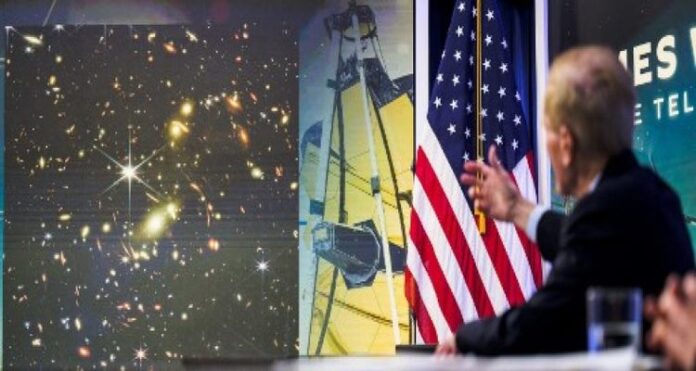| Translate This News In |
|---|
NASA announced Monday that the James Webb Space Telescope, the most powerful observatory ever placed in orbit, has revealed the “deepest and clearest infrared image of the early universe” ever taken, dating back 13 billion years. The stunning image, revealed by President Joe Biden in a White House briefing, is teeming with thousands of galaxies and features the faintest items ever observed, colorized from infrared to blue, orange, and white tones. “This telescope is one of the great engineering achievements of humanity,” he said.
Webb’s First Deep Field depicts SMACS 0723, a galaxy cluster that acts as a gravitational lens, magnifying even more distant galaxies behind it.
These faint background galaxies have been brought into sharp focus by Webb’s primary imager NIRCam, which operates in the near infrared spectral region because light from the expansion of the universe has been stretched out by the time it reaches us.
Webb completed the fibreglass shot in 12.5 hours, outperforming the Hubble Space Telescope by weeks.
The next batch of pictures will be available on Tuesday.
Initial goals
An international committee decided that the Carina Nebula, a massive cloud of dust and gas 7,600 light years away, would be included in the first wave of images.
The Carina Nebula is known for its towering pillars, including “Mystic Mountain,” a three-light-year-tall cosmic zenith captured in an iconic photo by the Hubble Space Telescope, humanity’s premier space observatory until now.
Webb has also performed spectroscopy (light analysis that reveals detailed information) on WASP-96 b, a distant gas giant discovered in 2014.
WASP-96 b, located nearly 1,150 light-years away, has 1/2 the mass of Jupiter and orbits its star in 3.4 days.
Previous exoplanet spectroscopy is a technique using existing instruments, according to STSI astronomer Nestor Espinoza, which were very limited in comparison to what Webb could do.”It’s like being in a very dark room with only a small pinhole to look through,” he said of the previous technology. “You’ve decided to open a huge window, you could see all the little details,” Webb says now.


















